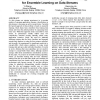Free Online Productivity Tools
i2Speak
i2Symbol
i2OCR
iTex2Img
iWeb2Print
iWeb2Shot
i2Type
iPdf2Split
iPdf2Merge
i2Bopomofo
i2Arabic
i2Style
i2Image
i2PDF
iLatex2Rtf
Sci2ools
SIGMOD
2006
ACM
2006
ACM
An automatic construction and organization strategy for ensemble learning on data streams
As data streams are gaining prominence in a growing number of emerging application domains, classification on data streams is becoming an active research area. Currently, the typical approach to this problem is based on ensemble learning, which learns basic classifiers from training data stream and forms the global predictor by organizing these basic ones. While this approach seems successful to some extent, its performance usually suffers from two contradictory elements existing naturally within many application scenarios: firstly, the need for gathering sufficient training data for basic classifiers and engaging enough basic learners in voting for bias-variance reduction; and secondly, the requirement for significant sensitivity to concept-drifts, which places emphasis on using recent training data and up-to-date individual classifiers. It results in such a dilemma that some algorithms are not sensitive enough to concept-drifts while others, although sensitive enough, suffer from un...
| Added | 08 Dec 2009 |
| Updated | 08 Dec 2009 |
| Type | Conference |
| Year | 2006 |
| Where | SIGMOD |
| Authors | Yi Zhang, Xiaoming Jin |
Comments (0)

